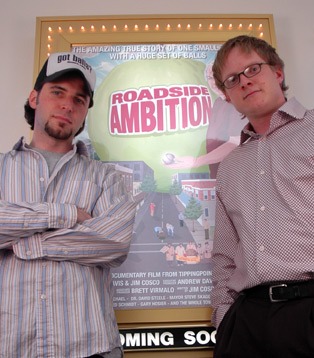
Small Company Shoots Big
Written by Mike Kennedy | Posted by: Anonymous
Big ideas make the best movies, and the founders of Tippingpoint Labs, a Newton-based marketing agency, are full of them. Producer Andrew Davis and Director Jim Cosco founded the small five man shop two years ago, but just because their company is small it doesn’t mean they don’t think big. Although they make their money by producing creative videos, multimedia presentations, and websites for corporate clients, the founders at Tippingpoint wanted to add profitable documentaries to their repertoire. They just needed a big idea. Enter Alexandria, Indiana native Michael Carmichael. Not only did this small town man have a dream big enough to carry a feature length documentary, Mike had some big balls — literally.
For the past 27 years, Mike has been painting an ordinary baseball over and over and over again. Today his ball is covered with close to 19,000 layers paint and weighs 1,400 pounds. Mike, who ironically paints houses for a living, proclaimed his creation the "World’s Largest Ball of Paint" and it quickly grew so big that he had to hang it from a steel reinforced beam in his shed. His goal is to get it recognized by the "Guinness Book of World Records," but that’s not Mike’s big dream. Mike wants to use his ball of paint to save his hometown.
Ten years ago, Alexandria hit hard times. General Motors closed two nearby manufacturing plants leaving most of Mike’s friends and relatives without jobs. When the town’s jobs disappeared, the small town of 6,000 spiraled into a depression and Alexandria’s quaint downtown became deserted and started to fall apart. Its economy has been desperate for a boost ever since giving Mike a big idea– he was going to turn the "World’s Largest Ball of Paint" into a roadside attraction to bring tourists to town.
When Davis and Cosco heard about Mike and Alexandria, they knew they found the right story to mark Tippingpoint’s foray into documentary filmmaking. Two years later, "Roadside Ambition" is nearing the final stages of post production and the company is shopping it for distribution. NewEnglandFilm.com visited them at their Newton production office to find out some of the lessons they learned from making their first feature and their strategies for getting the movie seen.
Mike Kennedy: Why did you want to get into making documentaries and why did you think the time was right to start now?
Andrew Davis: The market for documentaries is real hot right now. It has been for a couple of years and now audiences are really opening up to them. And at least in relation to their budgets, they are becoming commercial successes. Reality television as conditioned audiences to docs and break out hits like "Super Size Me" have shown that audiences will pay to see interesting stories with low budgets, even if it’s from a first time filmmaker like Morgan Spurlock.
Jim Cosco: Andrew and I both have a background producing news and public affairs shows, so shooting a documentary wasn’t a stretch. An interesting story is the most important ingredient for any movie, whether you’re talking about the next summer blockbuster or a documentary. For us, the advantage of making a doc is that we don’t have to rely on finding actors good enough to carry the script or worry about investing tens of thousands to shoot on film. With Mike, we had a story as interesting as anything we could make up and we knew we could afford to make it.

Moving the ball of paint.
[Click to enlarge]
MK: Which leads to how you financed it.
Davis: So far we’ve been lucky enough to finance it all ourselves. It’s a Tippingpoint Labs film, so the company is investing profits we make from doing things like industrial videos and webcasts into production. The most expensive part is our time. When were shooting or editing we aren’t out making the company money. But we’re looking at it as a long term investment. We’re planning on making it all back when we sell it.
MK: Production-wise, the movie looks really good. How did you shoot it and what did you use?
Cosco: We shot the whole thing on digital video. Audiences don’t cringe when they see a doc shot on video like they would otherwise. Only a handful of documentaries are still shot on film so audiences are quick to accept look of video in this genre. And now that filmmakers have access to 24P cameras, pro mist filters, affordable high definition camcorders, and other post production tricks, the cost of shooting on film is hard to justify. Especially, because shooting a doc you burn a lot of tape waiting to see what happens. So we stuck with digital video and posted the movie on an Avid. We only used a two person crew. Our camera package was small and mobile enough that I was shooting and Andrew was holding the boom.
MK: Unlike a lot of documentaries where the filmmaker sits back and subjectively records the action, you inserted yourself into the plot and in a lot of instances prodded Mike along from behind the scenes to help him do things he never would have done on his own. Did you cross a line in making a documentary in the truest sense?
Davis: I don’t think so. We set out to tell the most interesting story we could, and that meant we sometimes had to get directly involved in small town politics and push for things to happen, like "Ball of Paint Day," that might not have happened on their own. But even though we were the catalyst, it all happened and it’s all true. It’s nothing that Michael Moore hasn’t done on a grander scale.
MK: What’s been the reaction to the movie so far?
Cosco: We held a private screening after the initial cut to get feedback from an unbiased audience, and it was defiantly worth doing. We got about 100 people to fill out a survey and it helped us decide what worked and what didn’t. Andrew and I wrote and edited the whole thing so it was hard to step back and really look at it. We got too attached to it too quickly and the screening gave us great ideas on what to take out, what to shorten, and what questions we still needed to answer. We took that feedback and now we’re in the process of rewriting the script to include an omniscient narrator that the audience never sees. Once we add that, we will be close to being finished.
MK: What’s the next step for getting the movie seen?
Davis: Marketing, marketing, marketing. Making a great movie is one thing, but no one will want to buy it or see it without a good marketing plan. Tippingpoint Labs is essentially a boutique marketing agency, so the company isn’t stopping by financing just the production. We used our resources to build a strong branding campaign, designed original artwork, a professional press kit, a website crammed full of video, we send out a monthly newsletter, and invested in all the other trimmings you need to get a movie out there.
Cosco: The investment has been well worth it so far. Based on the strength of its one sheet, website, and trailer, we’ve had requests from about 10 distributors, some of them big ones, to screen the movie. The hard part is keeping them interested and thinking about the movie until we have a final cut that we’re happy with to show them. You only get one chance to impress a buyer so you want to show them the best product you can. Once they say no then forget it.
MK: This is a completely new direction for your company. What has been your motivation for making this movie and getting into doc filmmaking as a whole?
Davis: Like anything else we do at Tippingpoint Labs, making "Roadside Ambition" was a business decision. Although we’re passionate about making movies and think Mike had a great story to tell, we didn’t do it for ourselves or to satisfy our own creative egos. It’s not worthwhile for us to make a movie that no one will see, and it’s not worthwhile to pour thousands of dollars into a project that won’t eventually make a profit.
Cosco: It’s been a blast making this movie and we are already looking for our next project. As long as "Roadside Ambition" makes some money we’ll make another doc. In the overall scope of things, making a movie like this is a relatively cheap investment and the payoff could be huge. I think even if we just break even we’ll get the bug again.
More information on the movie can be found at www.roadsideambition.com. Read more about Tippingpoint Labs at www.tippingpointlabs.com.










